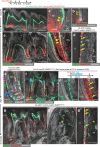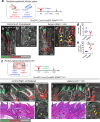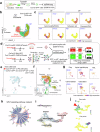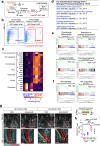Wnt-directed CXCL12-expressing apical papilla progenitor cells drive tooth root formation
- PMID: 40595672
- PMCID: PMC12216879
- DOI: 10.1038/s41467-025-61048-x
Wnt-directed CXCL12-expressing apical papilla progenitor cells drive tooth root formation
Abstract
The tooth root is a critical component of the tooth anchored to surrounding alveolar bones. Tooth root formation is driven by cells in the apical papilla (AP) that generate new dentin-forming odontoblasts at the root-forming front. Mesenchymal stem cells have been isolated from AP for regenerative use; however, how AP cells physiologically coordinate tooth root formation remains undefined. We find that CXCL12+ cells emerge in AP under hypoxic environments at the onset of tooth root formation. Using Cxcl12-creER-based cell-lineage analysis, we further find that CXCL12+ AP cells contribute not only to odontoblasts but also to cementum-forming cementoblasts of the elongating root, while showing plasticity to alveolar bone osteoblasts under regenerative conditions. Canonical Wnt inactivation inhibits odontoblast fates of CXCL12+ AP cells and induces substantial root truncation, with their aberrant fibroblast fates suppressed by TGF-β receptor inhibitor galunisertib. Therefore, CXCL12+ AP cells maintain odonto-cementogenic fates in a Wnt-dependent manner, identifying these cells as pivotal dental mesenchymal progenitor cells driving tooth root formation with substantial plasticity.
© 2025. The Author(s).
Conflict of interest statement
Competing interests: The authors declare no competing interests.
Figures







References
-
- Nanci, A. Ten Cate’s Oral Histology. (Elsevier Health Sciences, 2017).
-
- Cho, M. I. & Garant, P. R. Development and general structure of the periodontium. Periodontol 200024, 9–27 (2000). - PubMed
-
- Ten Cate, A. R. The development of the periodontium-a largely ectomesenchymally derived unit. Periodontol 200013, 9–19 (1997). - PubMed
-
- Nanci, A. & Bosshardt, D. D. Structure of periodontal tissues in health and disease. Periodontol 200040, 11–28 (2006). - PubMed
MeSH terms
Substances
Grants and funding
- R01 DE029181/DE/NIDCR NIH HHS/United States
- UL1 TR003167/TR/NCATS NIH HHS/United States
- R01DE030416/U.S. Department of Health & Human Services | NIH | National Institute of Dental and Craniofacial Research (NIDCR)
- R01DE029181/U.S. Department of Health & Human Services | NIH | National Institute of Dental and Craniofacial Research (NIDCR)
- R01 DE026666/DE/NIDCR NIH HHS/United States
LinkOut - more resources
Full Text Sources
Medical
Molecular Biology Databases

